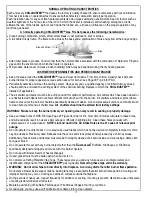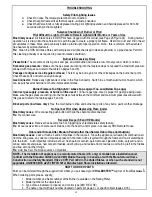
18
®
NOTE—The installation of appliances in a manufactured home (U.S. only) or mobile home installation must
conform with the Standard
CAN/CSA Z240 MH, Mobile Housing,
in Canada, or with the
Manufactured Home
Construction and Safety Standard, Title 24 CFR, Part 3280,
in the United States, or when such a standard is not
applicable,
ANSI/NCSBCS A225.1/NFPA 501A, Manufactured Home Installations Standard.
TROUBLESHOOTING
Safety Pilot Lighting Issues
●
Check for loose Thermocouple terminal nut connection.
●
Check that pilot flame strikes thermocouple—Adjust as needed.
●
Check that Valve Knob is fully depressed during pilot lighting operation and held depressed for 30 to 60
seconds with pilot flame lighted.
Nuisance Shutdown of Burner or Pilot/
Pilot Difficult to Light or Unable to Remain Lighted After Months or Years of Use
Most likely cause:
Air intake holes in ODS Pilot have clogged with lint or dust (see Page 20 Figure 34) . During normal
operation, air is drawn into these holes to mix with the gas to create a proper pilot flame. Over time, dust and lint in the air
accumulates in these holes, and eventually builds up to disrupt proper operation. Note: this is common with all vented
free heaters by all manufacturers.
Fix:
Clean the ODS Air Intake Holes with compressed air (like that used to clean keyboards) or a pipe cleaner. Perform
this cleaning annually or as required to prevent nuisance shutdown.
Burner is Excessively Noisy
Please Note:
The movement, mixing of air and gas, and combustion will create a low, throaty sound, which is normal..
Excessive gas pressure:
Make sure the gas pressure coming into the fireplace does not exceed the maximum pressure
allowed with this gas set (refer to the table on pages 5 and 6).
Passage of air/gas across irregular surfaces:
There may be burrs, paint or other blockages on the burner bar ports.
Check these ports and remove any blockage.
Gas Connector:
Relieve any tight bends or kinks in the Flex Connector. Switch to a smooth aluminum connector, which
can be purchased at hardware or home improvement stores.
Burner Flame is Too High (8-12” Above Top Logs) or Too Low (Below Top Logs)
Incorrect gas supply, pressure, or burner orifice used:
1) Ensure gas type of set is proper for gas type being used.
Make sure the gas pressure coming into the fireplace falls between the minimum and maximum pressures allowed with
this gas set (refer to the tables pages 5 and 6).
Blocked ports (low flame only):
Free the main burner orifice and burner bar ports of any burrs, paint or other blockage.
No Spark at Pilot when Depressing Piezo Igniter
Most likely cause
: Wire connecting push button with pilot has become disconnected
Fix
: Reconnect wire.
Receiver Beeps (SE and RE Models)
Most likely cause
: Receiver has become too hot, triggering over-temperature safety feature.
Fix
: Move receiver into a cooler area of firebox, onto the hearth, and/or place in accessory RH3 Remote House.
Odor and/or Smoke After Break-in Period (other than Natural Odor of Gas Combustion)
Most likely causes
: Lack or fresh air and/or impurities in the room air. Since the appliance is drawing its combustion air
from the living area, any odors or impurities present in the room will be recycled through the flame and re-circulated back
into the room. Such impurities include: pet hair, fresh paint or varnish, paint remover, cigarette smoke, potpourri and in-
cense, cements and glues, new carpet or textiles, dust build-up, and residue from previous wood burning left in the firebox.
and flue, among other things.
Fix
: Add fresh air. Remove sources of impurities.
HOW TO ORDER PARTS
Parts can be ordered through the supplier from whom you purchased your
CHILLBUSTER™
Log Set or from
Rasmussen
.
When ordering parts, please specify;
1. Model number and Serial number of the Burner (available on the Rating Plate).
2. Model number of the objects set.
3. Type of Gas (natural or propane) and control type (ME, RE or SE)
4. The name of part with part number (located on parts list, page 3) or specific object (pages 9-18).
















